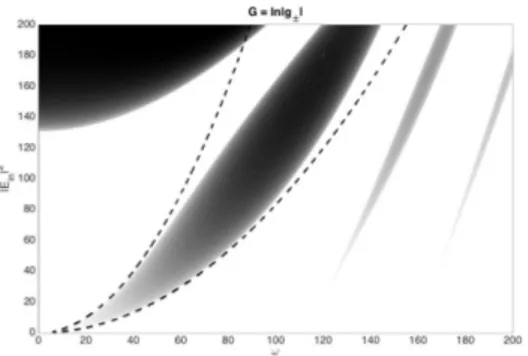Optical frequency comb generation beyond the Lugiato-Lefever equation
Tobias Hansson1,2and Stefan Wabnitz2
1Department of Applied Physics, Chalmers University of Technology, SE-41296 G¨oteborg, Sweden 2Dipartimento di Ingegneria dell’Informazione, Universit`a di Brescia, via Branze 38, 25123 Brescia, Italy
The generation of optical frequency combs in microresonator devices is currently a topic of intense research. A continuous wave pump field can be converted into a broadband frequency comb in an optical resonator that is filled with a nonlinear medium. Optical frequency combs have the potential to become key components in a great number of applications in e.g. frequency metrology, spectroscopy, optical clocks and wavelength-division-multiplexing sources [1].
The generation of Kerr frequency combs has so far been considered for relatively low intracavity power levels in the regime where the mean-field approximation is valid. The dynamics can then be described by either the Lugiato-Lefever equation (LLE) or using the theory based on coupled mode equations. A more accurate description is given by the Ikeda map, Eqs.(1-2), which relates the field Em(t,z), described by the Schr¨odinger equation, at roundtrip
m to the field at the beginning of the next roundtrip m + 1. The LLE can be derived by averaging the Ikeda map over one roundtrip [2]. The LLE approximation is in excellent agreement with experimental results whenever the characteristic nonlinear and dispersive length scales are much longer than the cavity length L. However, the approximation starts to breaks down when the nonlinear length scale becomes comparable to the length of the cavity. This regime of resonator dynamics has so far not been widely explored.
Em+1(t,z) =√θE in+√1 − θeiφ0Em(t,L) (1) ∂Em(t,z) ∂z =− αi 2Em(t,z) − i β2L 2 ∂2Em(t,z) ∂t2 +iγL|Em(t,z)|2Em(t,z) (2)
In this presentation we report on theoretical analysis and numerical simulations of the Ikeda map beyond the LLE approximation. We show that new features such as period doubled patterns and instabilities appear that cannot be modeled using the mean-field theory, cf. Fig. 1. Period doubling has so far only been experimentally observed in fiber ring resonators [3] and not in microresonators. However, we predict that such effects could be observable also in highly nonlinear semiconductor microring resonators for sufficiently large pump powers. Period doubling instabilities may be particularly important for normal dispersion cavities where they are the first instability to appear as the pump power is increased.
We demonstrate that additional multi-valued stationary states can appear for the continuous wave solution beyond the well known bistable response, see Fig. 2. These states correspond to large intracavity fields and may surprisingly also be present for the same range of pump parameters as the bistable response. We show that these states can be associated with localized soliton solutions which allows for the generation of super energetic cavity solitons. These cavity solitons have a larger peak intensity and narrower width than ordinary cavity solitons. Consequently, they also possess spectras with broader bandwidth, with intriguing possibilities for the generation of mode-locked octave spanning frequency combs.
Fig. 1. Parametric instability tongues of the Ikeda map for anomalous dispersion. The dashed contour shows the predicted range of modulational instability for the LLE.
Fig. 2. Comparison of pump dependence on the intracavity field intensity for multi-valued stationary continuous wave solutions of the LLE (dashed) and the Ikeda map (solid).
References
[1] T. J. Kippenberg, R. Holzwarth, and S. A. Diddams, “Microresonator-Based Optical Frequency Combs,” Science332, 555 (2011) [2] S. Coen, H. G. Randle, T. Sylvestre, and M. Erkintalo, “Modeling of Octave-Spanning Kerr Frequency Combs using a Generalized Mean-Field Lugiato-Lefever Model,” Opt. Lett.38, 37 (2013)
[3] S. Coen, M. Haelterman, P. Emplit, L. Delage, L. M. Simohamed, and F. Reynaud, “Experimental Investigation of the Dynamics of a Stabilized Nonlinear Fiber Ring Resonator,” J. Opt. Soc. Am B15, 2283 (1998)
